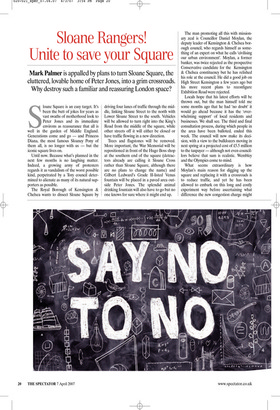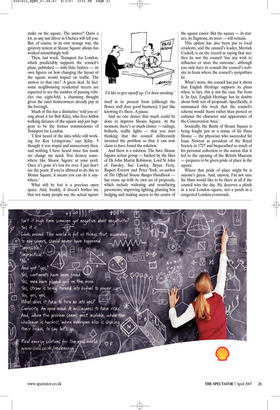Sloane Rangers!
Unite to save your Square
Mark Palmer is appalled by plans to turn Sloane Square, the cluttered, lovable home of Peter Jones, into a grim crossroads. Why destroy such a familiar and reassuring London space?
Sloane Square is an easy target. It’s been the butt of jokes for years as vast swaths of motherhood look to Peter Jones and its immediate environs as reassurance that all is well in the garden of Middle England. Generations come and go — and Princess Diana, the most famous Sloaney Pony of them all, is no longer with us — but the iconic square lives on.
Until now. Because what’s planned in the next few months is no laughing matter. Indeed, a growing army of protesters regards it as vandalism of the worst possible kind, perpetrated by a Tory council determined to alienate as many of its natural supporters as possible.
The Royal Borough of Kensington & Chelsea wants to dissect Sloane Square by driving four lanes of traffic through the middle, linking Sloane Street to the north with Lower Sloane Street to the south. Vehicles will be allowed to turn right into the King’s Road from the middle of the square, while other streets off it will either be closed or have traffic flowing in a new direction.
Trees and flagstones will be removed. More important, the War Memorial will be repositioned in front of the Hugo Boss shop at the southern end of the square (detractors already are calling it Sloane Cross rather than Sloane Square, although there are no plans to change the name) and Gilbert Ledward’s Grade II-listed Venus fountain will be placed in a paved area outside Peter Jones. The splendid animal drinking fountain will also have to go but no one knows for sure where it might end up. The man promoting all this with missionary zeal is Councillor Daniel Moylan, the deputy leader of Kensington & Chelsea borough council, who regards himself as something of an expert on what he calls ‘civilising our urban environment’. Moylan, a former banker, was twice rejected as the prospective Conservative candidate for the Kensington & Chelsea constituency but he has relished his role at the council. He did a good job on High Street Kensington a few years ago but his more recent plans to reconfigure Exhibition Road were rejected.
Locals hope that his latest efforts will be thrown out, but the man himself told me some months ago that he had ‘no doubt’ it would go ahead because it has the ‘overwhelming support’ of local residents and businesses. We shall see. The third and final consultation process, during which people in the area have been balloted, ended this week. The council will now make its decision, with a view to the bulldozers moving in next spring at a projected cost of £5.5 million to the taxpayer — although not even councillors believe that sum is realistic. Wembley and the Olympics come to mind.
What seems extraordinary is how Moylan’s main reason for digging up the square and replacing it with a crossroads is to reduce traffic, and yet he has been allowed to embark on this long and costly experiment way before ascertaining what difference the new congestion charge might make on the square. The answer? Quite a lot, as any taxi driver in Chelsea will tell you. But, of course, in its own strange way, the gyratory system at Sloane Square always has worked astonishingly well.
Then, last week, Transport for London, which predictably supports the council’s plans, published — with little fanfare — its own figures on how changing the layout of the square would impact on traffic. The answer to that one? A great deal. In fact, some neighbouring residential streets are expected to see the number of passing vehicles rise eight-fold, a charming thought given the rates homeowners already pay in the borough.
Much of this has a distinctive ‘told you so’ ring about it for Bob Kiley, who lives within walking distance of the square and just happens to be the former commissioner of Transport for London.
‘I first heard of the idea while still working for Ken Livingstone,’ says Kiley. ‘I thought it was stupid and unnecessary then, and nothing I have heard since has made me change my mind. You destroy somewhere like Sloane Square at your peril. Once it’s gone it’s lost for ever. I just don’t see the point. If you’re allowed to do this to Sloane Square, it means you can do it anywhere.’ What will be lost is a precious open space. And, frankly, it doesn’t bother me that not many people use the actual square itself in its present form (although the flower stall does good business), I just like knowing it’s there. A pause.
And no one denies that much could be done to improve Sloane Square. At the moment, there’s so much clutter — railings, bollards, traffic lights — that you start thinking that the council deliberately invented the problem so that it can now claim to have found the solution.
And there is a solution. The Save Sloane Square action group — backed by the likes of Dr John Martin Robinson, Lord St John of Fawsley, Sue Lawley, Bryan Ferry, Rupert Everett and Peter York, co-author of The Official Sloane Ranger Handbook has come up with its own set of proposals, which include widening and resurfacing pavements, improving lighting, planting box hedging and making access to the centre of the square easier. But the square — its statues, its flagstone, its trees — will remain.
This option has also been put to local residents, and the council’s leader, Merrick Cockell, is on the record as saying that neither he nor the council ‘has any wish to influence or steer the outcome’, although you only have to consult the council’s website to learn where the council’s sympathies lie.
What’s more, the council has put it about that English Heritage supports its plans when, in fact, this is not the case. Far from it. In fact, English Heritage has its doubts about both sets of proposals. Specifically, it announced this week that the council’s scheme would ‘harm rather than protect or enhance the character and appearance of the Conservation Area’.
Ironically, the Battle of Sloane Square is being fought just as a statue of Sir Hans Sloane — the physician who succeeded Sir Isaac Newton as president of the Royal Society in 1727 and bequeathed so much of his personal collection to the nation that it led to the opening of the British Museum — prepares to be given pride of place in the square.
Where that pride of place might be is anyone’s guess. And, anyway, I’m not sure Sir Hans would like to be there at all if the council wins the day. He deserves a plinth in a real London square, not a perch in a congested London crossroads.



































































 Previous page
Previous page